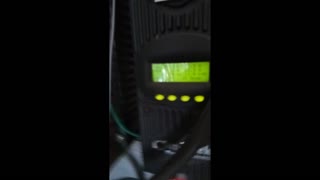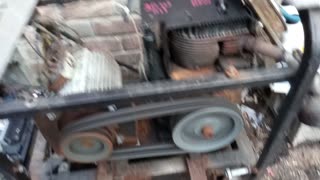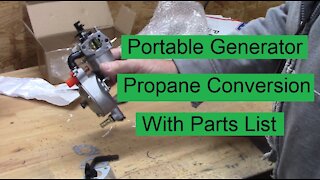Convert Generator to Natural Gas, LP Propane. Tri-Fuel. No kit. Read below on how to.
Installation for tri-Fuel Conversion, no kit, to run generator on LP or Natural gas.
4 KEYS (1) PRESSURE-REGULATOR $72 (2) Hose location (3) an inline valve to quickly adjust regulator from, hardware $10 (4) Choke Open and gas line to motor shut off.
Motors will start up easily with gas or LP, but if using natural gas, it may start hard, I use a small shot of either, carburetor cleaner, gasoline (cheap syringe with gas, hole drilled by carburetor) or a can of starting fluid to get the motor to start up for one combustion, 1/2 second, so suction from carburetor will turn on regulator to run motor on natural gas or LP!
GOAL: Engine to start for a 1/2 second then the PRESSURE-REGULATOR will continue to feed the motor, you will then have to quickly adjust valve the first time, to know how much feed your motor needs to run on. Then fine adjustment to lean side, as lean as possible for power.
HOSE: 18" or less, mine would only work with a 9' hose! Hole from regulator to carburetor intake, drilling through air cleaner cover. Slim down 1" of a gas line hose at one end, set it about 1/8" into the intake vacuum of the carburetor throat, (like video) touching carburetor or very close to air "intake”, not blocking the air flow, yet, getting suction. It will work! Just play with where hose sets at intakes vacuum, and use a valve to adjust Natural Gas or LP, like on video, so you can "QUICKLY" adjust and "SEE" where valve should be set for your motor. That inline valve allows one to easily, quickly, adjust.
TEST, TO FIND INLINE VALVE LOCATION: If having a hard time starting, start generator with gasoline, then with choke open, shut gasoline line off, as the motor dies turn on Natural Gas or LP regulator inline valve, ADJUSTING the valve to find where it runs. Once running, run it on the lean side, then "mark/REMEMBER" that location, I have to start mine with valve fully open, once running I quickly move it to my marked location. Lean, meaning, the valve is closer to off, yet the motor still running smooth. Lean gets the most power from motor because it allows more oxygen to the motor.
NO CHOKE: (nor even the carburetor needed). Leave choke open because regulator air hose is set "before" the choke, and needs the vacuum. You may need choke closed to start on gasoline in cold weather, but quickly close it.
WHY NOT GASOLINE: Troubles with carburetors and a lot of work storing and refreshing the gasoline cans. You will never again have to worry about it starting up because of the carburetor problems, like being gummed up. (Just spray fresh gas or started fluid in carburetor to start)! If on natural gas it will run until it is out of oil! No more refills, storing, or gas stations trips needed!
BE SAFE: Buy a PRESSURE-REGULATOR . Search for "Low Pressure Regulator (LPR) Natural Gas/LP KN Style". May 2022 Amazon was $60 on Ebay $72. It turns off the Natural Gas or LP gas flow if the motor dies. It will convert any motor up to 30hp and still allow use of gasoline if needed, it is the safest way on how to convert to a tri-fuel generator! Or, buy a kit, but it is triple the cost, and has a cheap adjustment valve and they may want you to take carburetor off to install it, or move brackets for clearance.
CAUTION: If using “starting fluid”, use with caution. On my 22hp lawn tractor I used it often, but I have sheared a pin on motor using starting fluid (on a warm day), which moved the timing! A new flywheel shear pin or shear key to fix it was only $3 for a pack of 3, but, flywheel has to come off to replace shear pin/key. I might use starting fluid in very cold weather, if I have trouble with gasoline, maybe? A (barbeque style) "syringe" from a dollar store, to squirt gas into carburetor intake has always worked, I drilled a small hole through the air cleaner cover, as seen on video, at an angle pointing into carburetor intake!
RUNNING PIPE OR HOSE TO REGULATOR: Before running a pipe to regulator, lookup charts for gas pipe sizes that's needed per distance on Natural gas. 1,000 BTU is needed per horsepower, so pipe distance and size needs to be considered. 12hp needs 12,000 BTU, if it gets less BTU, it will run but it will not give full power under a load, it will just sound like it. Chart shows pipe size needed and (consider putting line before stove or furnace), ya just can't run 1/2" pipe 100' for 12hp. Search for "gas flow charts for natural gas".
I spent more time and money on running a gas pipe (75') to generator than on the REGULATOR. If using LP you will also need a low pressure regulators at the LP tank, like seen on gas grills.
If desiring to know more or see more of my shed design and the odd (junk yard) trunk hinges, let me know in comments and I will do a closeup video of how they swing "up" then "open"..? Prepare for "days" of power outage! Good Luck.
-
 6:04
6:04
mach1sc
2 years agorun generator on natural gas
583 -
 4:22
4:22
mach1sc
2 years ago $0.01 earnedrun generator on natural gas video2
59 -
 19:14
19:14
Let's Figure This Out
2 years ago $0.01 earnedHarbor Freight Portable Generator Propane Conversion - With Parts List - Let's Figure This Out
88 -
 2:54
2:54
randyvdamron
2 years agoHow I start my day ?
13 -
 1:36:18
1:36:18
Squaring The Circle w/ Randall Carlson
1 day ago#005 Untangling The Propaganda Around Twisters
68.3K42 -
 13:31
13:31
Space Ice
1 day agoMovie "Shoot 'Em Up" Is So Good You'll Realize How Worthless You Truly Are - Best Movie Ever
62.5K32 -
 16:01
16:01
Bearing
1 day agoTikTok has Reached NUCLEAR Levels of CRINGE
56.3K42 -
 5:46
5:46
Chris Jericho
1 day agoTalk Is Jericho Highlight: Renny Harlin Talks The Strangers & Nightmare On Elm Street 4
46K4 -
 17:05
17:05
DEADBUGsays
1 day agoThe Beast Of Manchester
30.1K7 -
 4:54
4:54
ErmzPlays
13 hours agoHalo Composer Sets Gaming Industry ON FIRE By Coming Out As Republican
27.9K11